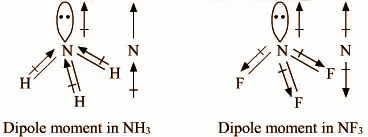Question
Question: Which out of \[N{H_3}\] and \(N{F_3}\) has a higher dipole moment and why?...
Which out of NH3 and NF3 has a higher dipole moment and why?
Solution
Dipole moment is a vector quantity and hence the resultant dipole moment in a molecule depends upon the direction of dipole moments of individual bonds. In NH3, Nitrogen has a lone pair and is more electronegative than hydrogen. In NH3, fluorine is more electronegative than nitrogen.
Complete answer:
In both molecules i.e., NH3 and NF3, the central atom (N) has a lone pair electron and there are three bond pairs. Hence, both molecules have a pyramidal molecular geometry. The dipole moment of ammonia (1.47D) is higher than the dipole moment of NF3 (0.24D). In each molecule, N atom has one lone pair.
In NH3, Nitrogen is more electronegative than H, so it will attract the shared pair of electrons towards itself. As a result, the dipole due to Nitrogen is in the same direction as the resultant dipole moment due to N-H bond & hence the net dipole increases.
Since in the case of NF3, fluorine is more electronegative than nitrogen, so it will attract the shared pair of electrons towards itself from nitrogen. As a result, the dipole due to all F is in the opposite direction to the resultant dipole due to N-F bonds, therefore the net dipole decreases.
F is more electronegative than H and N−F bond is more polar than N−H bond. Hence, NF3Is expected to have much larger dipole moment than NH3 However reverse is true as in case of ammonia, the direction of the lone pair dipole moment and the bond pair dipole moment is same whereas in case of NF3. It is the opposite. Thus, in ammonia molecules, individual dipole moment vectors add whereas in NF3, they cancel each other.

Dipole moment in NH3 Dipole moment in NF3
Hence, the net dipole moment of NF3 is less than that of NH3.
Note: Ammonia is an inorganic compound which is composed of a single nitrogen atom that is covalently bonded to three hydrogen atoms. It is manufactured as well as produced naturally from bacterial processes and the breakdown of organic matter. Ammonia is used in many industrial processes, and it is also used as a fertilizer and refrigerant. It is a colorless gas or compressed liquid which has a pungent odor and exposure occurs by inhalation, ingestion, or in contact.
